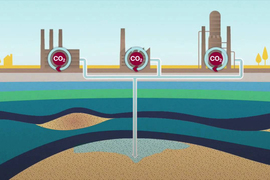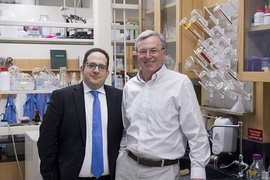The long-term goals of the Paris Agreement — keeping global warming well below 2 degrees Celsius and ideally 1.5 C in order to avert the worst impacts of climate change — may not be achievable by greenhouse gas emissions-reduction measures alone. Most scenarios for meeting these targets also require the deployment of negative emissions technologies (NETs) that remove carbon dioxide (CO2) from the atmosphere.
A leading NET candidate is bioenergy with carbon capture and storage (BECCS), which extracts energy from CO2-absorbing plants, captures CO2 that’s released into the atmosphere when the extracted plant matter is combusted, and stores it underground. The end-to-end process entails securing available land, cultivating and transporting crops, converting biomass into electricity with carbon capture, and transporting and storing the captured CO2.
On first glance, it may seem like a no-brainer to ramp up BECCS technology around the world to ensure that the international effort to stabilize the climate will succeed. But the prospect of cultivating plants for BECCS on a massive scale has raised concerns about adverse, unintended consequences. These include environmental impacts that range from soil erosion to biodiversity loss, and economic impacts, especially higher food prices that could result from redirecting vast tracts of agricultural land to draw down carbon emissions.
A new study in the journal Global Environmental Change focuses squarely on the economic implications of BECCS. Representing all major components of BECCS in the MIT Economic Projection and Policy Analysis (EPPA) model, researchers at the MIT Joint Program on the Science and Policy of Global Change and Imperial College London estimate the likely impacts of the technology on the global economy under climate policy scenarios that keep global warming below 1.5 C and 2 C, respectively.
They find that while it’s economically feasible to implement such policies without relying on BECCS, large-scale deployment of the technology in the second half of the century significantly lowers the overall implementation costs. Moreover, the inclusion of BECCS in these policies prevents widespread economic damages: in the 1.5 C scenario, global consumption decreases by almost 20 percent by 2100 without BECCS, but only by 5 percent with BECCS.
“Our modeling suggests that the benefits of BECCS far outweigh the costs,” says Howard Herzog, senior research engineer at the MIT Energy Initiative and co-author of the study. “In terms of costs, BECCS fares better than direct air capture, the other major negative emissions technology that uses carbon dioxide capture and storage (CCS).”
BECCS also significantly reduces the carbon prices associated with cap-and-trade policies designed to reduce emissions sufficiently to keep global warming below 1.5 C and 2 C. By creating negative emissions, the technology relieves pressure from the emissions cap and therefore lowers the price of emissions permits. At the same time, BECCS is compensated for its negative emissions through the carbon price, which is a substantial source of revenue.
“We conduct a series of experiments which robustly demonstrate that revenue from carbon permits is really driving the deployment of BECCS,” says Jennifer Morris, study co-author and research scientist at the MIT Joint Program and MIT Energy Initiative. “We find that the value of CO2 removal is far greater than the value of the electricity generation. Electricity is essentially a byproduct.”
Finally, the study concludes that while BECCS deployment results in major changes in land use to accommodate bioenergy crop cultivation consistent with meeting the 1.5 C and 2 C climate targets, it drives up the prices of food, livestock, and crops by less than 5 percent on average by 2100 (up to 15 percent in selected regions). Most notably, food prices rise by just 1.5 percent globally.
These results suggest that, in concert with dramatic emissions-reduction measures, BECCS could be an economically effective tool in the global effort to stabilize the climate.
“We have shown that large-scale deployment of BECCS could dramatically lower the costs of implementing policies aimed at meeting the long-term climate goals of the Paris Agreement, and avoid major price increases in agricultural commodities,” says MIT Joint Program deputy director and MITEI Senior Research Scientist Sergey Paltsev, who co-authored the study. “Further research is needed, however, to provide a more granular assessment of food supply chains and BECCS components, and to ensure that such deployment is politically viable.”










